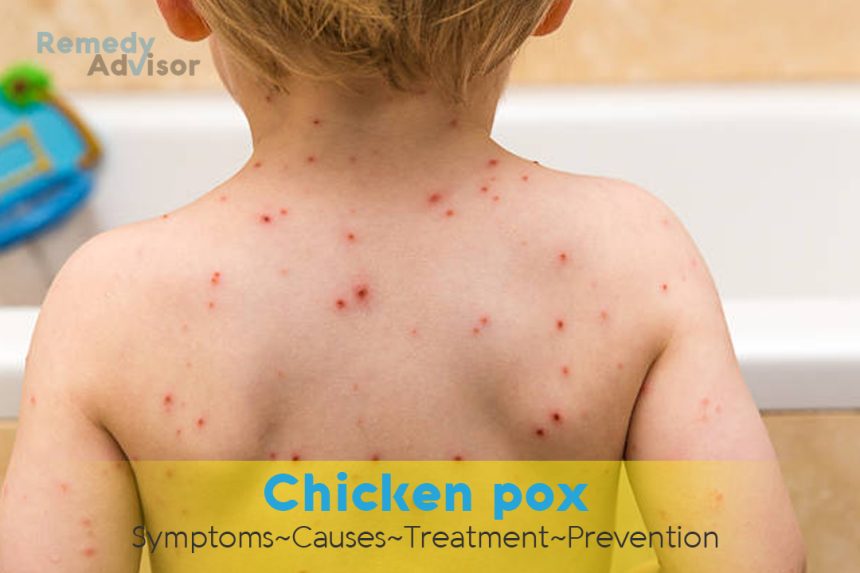What is it
Chicken pox is a very common, highly contagious disease that is usually mild in its course, which is marked by fever and a characteristic itchy rash. More than 90 percent of cases occur in children younger than nine years of age. Outbreaks are common among children in a household and in schools and day-care centers, often during the winter and spring.
Most adults have been exposed to chicken pox as children and, with rare exceptions, possess lifelong immunity to the disease. But unexposed adults are susceptible, and those who do get chicken pox generally have more severe symptoms and are at greater risk of complications than children.
Symptoms
The chief symptom of chicken pox is a rash. However, one or two days before the rash appears, some children develop a fever, which may be accompanied by headache, malaise, and/or a lack of appetite. It is important that you never give aspirin to children for fever if you suspect chicken pox. The combination of aspirin or aspirin-like drugs (salicy-lates) and the chicken pox virus is associated with an increased risk of Reye’s syndrome, a rare but potentially fatal liver and brain illness.
When the rash appears, it typically goes through several stages:
- Splotchy, red spots (pox) or pimples appear that, over the first few days, progress to small, fragile, fluid-filled blisters on top of an itchy, red rash.
- Over a period of about seven days, the blisters erupt and form a scab or crust; at this stage there may be intense itching.
- The rash often begins on the face or trunk and then spreads over the extremities in successive waves. Spots may also spread to the mouth, vagina, anus, or ears. There may be only a few sores or hundreds. Rashes at varying stages of eruption and healing maybe present at the same time. When all the blisters have scabbed, the scabs may last for another week.
- Any fever generally subsides once the rash has reached the scab stage.
What causes it
Chicken pox is caused by a form of herpes virus called varicella zoster. The virus is easily and rapidly spread from person to person through exposure either to cells from the skin lesions that are suspended in air or droplets from the mouth or nose.
A child who first shows symptoms is infectious for a week or so, beginning about a day before a rash appears and continuing until all the pox have dried up. Once the virus has been transmitted to a susceptible child, it will incubate in the body for 1 to 23 days before symptoms appear.
After lesions heal, the varicella zoster virus remains inside the body in a latent (inactive) form. Many years later the virus may become reactivated, causing the painful ailment shingles (herpes zoster), which occurs in about 15 percent of the population.
What if you do nothing
The rash may be uncomfortable, but most cases of chicken pox clear up without complications in 10 to 14 days though some scabs may take up to 20 days to heal. The scabs may leave behind light scars, but these will fade.
One possible complication is a secondary bacterial infection of the skin. Infection with Group A streptococci, for example, can spread through cracks in the skin and invade the body, causing potentially life-threatening disease. Those with cancer or compromised immune systems may take a longer time to heal and are at greater risk of serious complications, including pneumonia or brain infections.
Pregnant women who have never had chicken pox should avoid anyone with the disease. In rare cases chicken pox in pregnant women damages the fetus. Newborns should also be kept away from those with the disease. Chicken pox in newborns can be quite severe and is sometimes fatal although most infants possess protective maternal antibodies against the illness.
Home remedies
There is no cure for chicken pox, but you can relieve the symptoms. Remember to never use aspirin for lowering fever. Also be aware that many over-the-counter remedies, including herbal preparations, contain aspirin. To reduce fever and relieve aches, use acetaminophen instead.
Plenty of rest is helpful
Children need not be kept in bed constantly, but their activity should be limited.
Relieve itching
Dab calamine lotion on affected areas twice a day with sterile gauze. Over-the-counter antihistamine creams may also help, as can cool baths. Add a handful of ground instant or colloidal oatmeal (available in pharmacies), or a half a cup of baking soda or cornstarch, to the bath water Pat, don’t rub, the skin dry.
Keep skin clean
Sponge baths a few times a day will also help to keep scabs and blisters clean and free of infection. Have infected children wash their hands frequently with antibacterial soap.
Don’t scratch
Scratching can cause blisters to become infected, leading to permanent scarring. Cut a child’s fingernails short. Gloves or mittens may be worn to prevent scratching during sleep.
If blisters have formed in the mouth
Gargling with salt water (a half teaspoon of salt per cup of water) may bring relief.
Prevention
Get vaccinated
A safe and effective chicken pox vaccine is available. It is recommended for children a year or older who are in good health, and for adults who have never had the disease. A single dose is given to children 1 to 12 years of age. Adolescents and adults get two doses four to eight weeks apart.
Avoid infecting others
A child with chicken pox should stay home at least until all scabs have dried completely at which point the infection won’t be spread. (This applies to infected adults as well.) Friends, playmates, or schoolmates indeed, anyone who has come in contact with the infected person in the preceding few days should be informed about the situation. Susceptible adults, especially pregnant women, should take care to avoid contact with anyone infected and newborns should be kept away. Children can return to school once the last blisters have crusted over.







